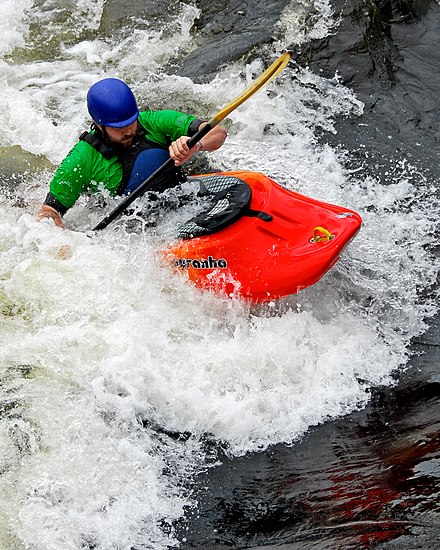
Canoe freestyle (also known as playboating) is a discipline of whitewater kayaking or canoeing where people perform various technical moves in one place (a playspot), as opposed to downriver whitewater canoeing or kayaking where the objective is to travel the length of a section of river (although whitewater paddlers will often stop and play en route). Specialised canoes or kayaks (boats) known as playboats are often used, but any boat can be used for playing. The moves and tricks are often similar to those performed by snowboarders, surfers or skaters, where the athlete completes spins, flips, turns, etc. With modern playboats it is possible to get the kayak and the paddler completely airborne while performing tricks.[1] The competitive side of playboating is known as freestyle kayaking (formerly called rodeo).
Playspots are typically stationary features on rivers, in particular standing waves (which may be breaking or partially breaking), hydraulic jumps, 'holes' and 'stoppers', where water flows back on itself creating a retentive feature (these are often formed at the bottom of small drops or weirs) or eddy lines (the boundary between slow moving water at the rivers' edge, and faster water).
Basic moves consist of front- and back-surfing, spins through any of the three axes; air screws, cartwheels and air loops (invented by Clay Wright), stalls with the kayak vertical on either end, and getting airborne (bouncing the boat on a wave, or submerging part of the kayak so that it pops out when it re-emerges). The playboater usually aims to stay surfing the feature after performing each move (as opposed to being washed off). More complex moves are made up of combinations of these moves.
These moves were more popular before short playboats were invented, but remain the foundation of several current moves.




Playboating has grown in popularity in recent years due to innovations in boat design. Modern playboats are made from plastic which is much more robust than glass fibre or wood. Playboats typically have much less volume in the bow and stern than dedicated river-running kayaks. This allows the paddler to easily dip either end underwater.
Playboating is mainly done for fun, but competitions are also popular. Paddlers have a set time to perform as many moves as possible, and score additional points for style.
There are [[ICF Canoe Freestyle World Championships ]] held under the banner of the International Canoe Federation as well as a variety of different national and regional championships. The most recent World Championships was held in Columbus, USA with over 100 athletes.
Visiting a playspot where you do not need to commit to a full river run to get there (which involves shuttling cars to the bottom of the river) is often referred to as 'Park and Play'. Playboating can often be more convenient and can in some circumstances can be considered safer than river running – in particular if the play spot is in an accessible area as opposed to numerous whitewater runs which exist in remote and inaccessible (in case of injury or rescue) areas.
Playboaters still generally follow right of way conventions that are commercially established. The vessel upstream of a feature has right of way over a vessel in the feature. This means that if a kayaker is surfing a wave, and a kayaker or a raft is coming downstream, the surfing kayaker should give way to the upstream paddler[s].
This general convention however is disregarded in many scenarios present in playboating:
Playboaters are a very diverse crowd, primarily because of the wide range of skill levels playboating can accommodate. Generally in regions where playboating is more popular than creeking or river running due to the surrounding rivers, beginners will enter the sport of kayaking in a playboat, or a cross over boat. This group of kayakers if often supported by either a paid instructor, club, or skilled paddling friend who often supplies instruction, gear, safety and clean up support. Beginners, club paddlers and lesson groups are generally friendly and welcoming to newcomers, and typically only paddle in warm weather months to avoid the need of buying expensive cold water gear.
The culture of playboaters also encompasses a group of kayakers who are called 'pro boaters' short for professional kayakers. These kayakers generally aspire to, or do, make money off of competitions, sponsorships, or media created on their playboating skills. There is a stereotype of 'pro boaters' to be elusive, self indulged, and wild; a stigma often enforced by the media the group produces. Professional kayakers generally range between the ages of 16 and 35, and generally do not make more than average income per year.[clarification needed]
The last major facet of playboaters that do not belong in the beginner / group culture, or the 'pro boater' culture is the local playboater. This type of playboater is usually good to advanced in skill level, and generally is a graduate of the beginner or group culture scene. They are identified by a tighter knit group of friends, and their knowledge of the play waves in their area. It is not uncommon to see local boaters and pro boaters surfing advanced waves, with a distinct differentiation between the two cultures identified by their equipment, their lack or presence of media equipment, and general attitude around the feature.